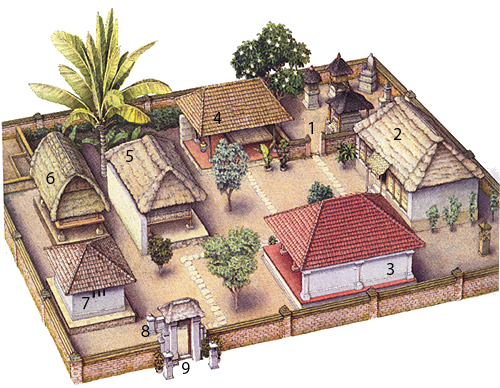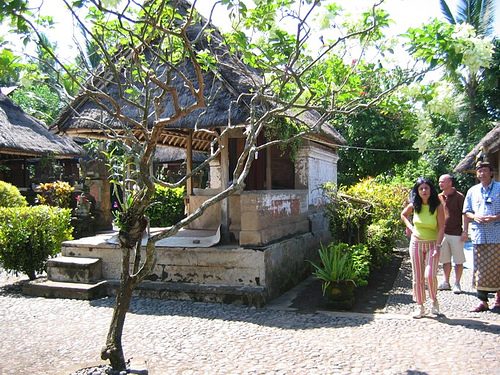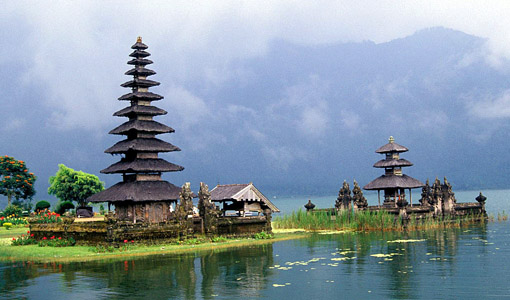Balinese House (kuren) consists of a family or a number of related families living within one enclosure, praying at a common family temple, with one gate and one kitchen. The square plot of land (pekarangan) in which the various units. of the house stand is entirely surrounded by a wall of whitewashed mud, protected from rain erosion by a crude roofing of thatch.
Although many modern Balinese houses, particularly in Denpasar or the larger towns, are arranged much like houses in the west, there are still a great number of traditional Balinese home. In Ubud, for example nearly house will follow the same traditional walled design. Like houses in ancient Rome the Balinese house looks inward; the outside is simply high wall. Inside there will be a garden and a separate small building or bale for each function. There will be one building for cooking, one building for washing and the toilet, and separate building for each” bedroom”.
What there won’t be is a living room” because in Bali’s mild tropical climate you live outside – the living room” and “dining room” will be open verandah areas, looking out into the garden. The whole complex is oriented on the kaja-kelod axis, between the mountain and the sea. In term of the human body, there’s a head- the family temple with its ancestral shrine: arms – the kitchen and rice storage building; and even an anus – the garbage pit.
There may be an area outside the house compound where fruit trees are grown or a pig may be kept. Usually the house is entered through a gate-way backed by a small wall known as the aling-aling. It serves a practical and a spiritual purpose, both preventing passer-by from seeing in and stopping evil spirits from entering. Evil spirit can not easily turn corners so the aling-aling stops them from simply scooting straight in through the gate.
Sources of Guidance to Build a House
An old Hindu’s manuscript called Lontar Asta Kosala Kosali is the chief guide to build a proper Balinese house. There are also other manuscripts, such as Lontar Asta Bumi (containing size of land and location a good house), Lontar Asta Dewa & Lontar Wisma Karma (containing the name, shape, and function of each a building), and Lontar Dewa Tattwa (containing clearance ceremony before a house is built). In many aspects of life, those guidance books have been developed depending on the surrounding, local topography.
Traditional Balinese House design :
1. Family Temple. The house temple called Sanggah or Merajan, is the place to worship the ancestor and the Hyang Guru.
2. Sleeping Pavilion. This building usually a large eight-post structure on a high base. A terrace usually attached for receiving guests at family ceremony.
3. West Pavilion or Bale Dauh, is the workhouse of the compound. Serving the variety of purposes, from gathering place to sleeping quarters
4. Ceremonial Pavilion, the East Pavilion or Bale Dangin is the ceremonial pavilion. The place is where the life rites and death rituals occur.
5. Sakenam, the guest pavilion for relatives and children varies in size and number according to the needs.
6. Granary or the Lumbung or Jineng is the storage area for rice.
7. Kitchen or Paon is in the South because of the association with Brahma (the god of fire) whose place in the South.
8. Protective Wall or Aling-Aling, most behind the gates to deflect the malign influences.






